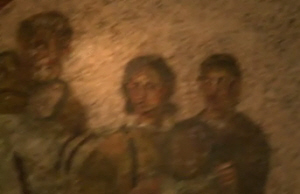Catacombs of St Priscilla
St. Paul and Phoebe
Hidden beneath the streets of Rome lies an intricate labyrinth of tunnels, known as the Catacombs of St Priscilla. They date to between the second and fourth centuries AD, when to be a Christian in Rome was to be a criminal. Down here lies in neglect, a piece of early Christian history.
This is where Christians were brought to be buried and clearly came when they were being persecuted. The catacombs were carved out of the bare rock. You can still see all the pickaxe marks on the ceilings and walls. It's almost as if you are being transported back to the very moment of Christianity's inception.
The Catacombs of St Priscilla
A remarkable cave drawing was only discovered a few years ago, and it dates from the second century AD, which makes it the oldest surviving image anywhere in the world of the Virgin Mary and Jesus. And that's what's so fantastic about coming down here, because you're absolutely up, face to face, with the very earliest days of Christianity.
What is especially fascinating about these tunnels is what it can show us about the role of women.
Incendiary Painting
In one corner, we find an image detailing what appears to be women presiding over a religious ritual, what today we might recognise
as the Eucharist or holy Communion. In another corner is an image which some people would consider incendiary.
There are two things that are notable about this particular painting. The obvious one is that the scene is dominated by the
figure of a woman. But then just have a look at this little group of three in the corner. There's a Bishop, and he's got his
hand on the shoulder of a woman. Now, she's wearing a piece of white cloth called an alb and that was a vestment that could only
be worn by ordained priests.
All over this subterranean world there are images of not just men leading worship, but women. Being here, it appears to me that the
early Christians had an inclusive, egalitarian take on who should lead their faith. The view is at odds with that of many Christians today.
Questo e il mio corpo offerto in sacrificio per voi.
Father Scott Brodeur
Father Scott Brodeur is a catholic priest and respected theologian at the prestigious Gregorian University in Rome. He prepares
men for the priesthood. He believes that key evidence about the role women should play in the church can be found in the Bible
itself, in a letter St Paul wrote to the citizens of Rome.
What he has to say may come as a surprise to some. St Paul in the letter to the Romans, chapter 16, verse one, says "I commend
to you our sister Phoebe, a deacon of the church at Cenchrea." And Paul, by sending her to Roma, is saying, look at this
extraordinary woman and I'm sending you one of our best and because I trust her, she's going to interpret this letter for you.
It is significant, because that's pretty much the most important job that you can give someone, to ask Phoebe to take the
teachings of Christ, the message of Jesus, to Rome, to the centre of the Roman world.
Father Brodeur "Absolutely. Paul is so aware of the importance of this letter. So she has a crucial role."
So do you think he's consciously making a point by choosing a woman?
Father Brodeur "Absolutely. The entire letter to the Romans is about
that there is no this common quality among us, that we all share the same value and worth."
Even the Bible itself suggests that in the first few centuries of Christianity, women played similar rules to men. But there
are clearly some who were troubled by this state of affairs.
